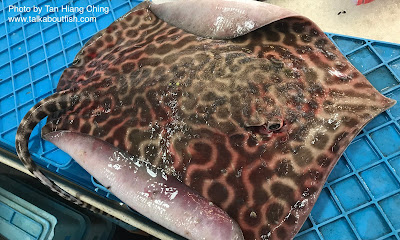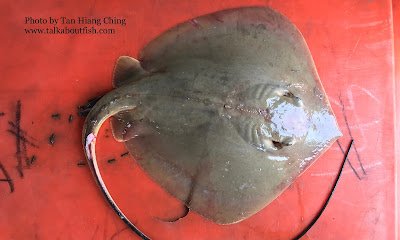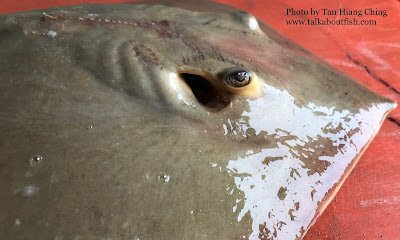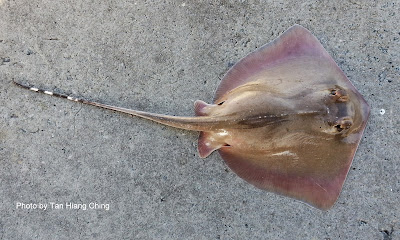Stingrays
Stingrays or whiprays are the common names for the members of the Dasyatidae family. They have broad, wing-like pectoral disc, and a very long whip-like tail armed with 1 to 4 spines. Their dorsal fin is totally absent or indistinct.
Members of the Dasyatidae are found in the warm-temperate and tropical continental seas worldwide. There are 8 known genera and 88 species worldwide. They are mainly marine. Several species are euryhaline and ascend rivers, while some species are confined to fresh water. They are mostly demersal in inshore, occurring on soft bottom in estuaries, lagoons, and enclosed and open bays. Their stinging spine, which is close to the tail base, is an effective defensive weapon, causing excruciating pain in human. All species are live-bearing. They feed mostly on benthic invertebrate.
Members of the Dasyatidae are found in the warm-temperate and tropical continental seas worldwide. There are 8 known genera and 88 species worldwide. They are mainly marine. Several species are euryhaline and ascend rivers, while some species are confined to fresh water. They are mostly demersal in inshore, occurring on soft bottom in estuaries, lagoons, and enclosed and open bays. Their stinging spine, which is close to the tail base, is an effective defensive weapon, causing excruciating pain in human. All species are live-bearing. They feed mostly on benthic invertebrate.
Scientific Name: Brevitrygon walga (Müller & Henle, 1841)
English Name: Dwarf Whipray, Scaly Stingray, Scaly Whipray
Chinese Name | 鱼类中文名: 魟鱼 (Hōng yú), 魔鬼鱼 (Móguǐ yú), 沃尔窄尾魟 (Wò ēr zhǎi wěi hóng)
Malay Name | Nama Melayu Malaysia: Ikan Pari Ketuka, Tuka, Pari Ketuka Tanjung
Bahasa Indonesia: Pari, Toka, Pari Kikir
Thai Name | ชื่อสามัญภาษาไทย: ปลากระเบนแคระ (Plā kra ben khæra)
Local Hokkien: Hung Heur
Local Teochew: Hung Hu, Piak Kia
Main Identification Features: Snout narrowly triangular. Disc almost oval. Mid-disc thorns absent or rudimentary. Tail short, not whip-like (end bulbous in adult females). Tail thorns very elongate. Grayish or brownish dorsally and whitish ventrally. Dorsal margin of disc not white.
Size: Maximum disc width 45 cm. Size at birth 8 to 10 cm disc width. Both sexes mature at 16 to 17 cm disc width.
Habitat and Ecology: Coastal waters, over soft bottoms, to 40 m depth. Feeds primarily of small crustaceans, but also small fishes.
Remarks: Two very venomous spikes at the tail of this particular species that can whip upward. Be very careful when handling all types of ray.

Scientific Name: Himantura fava (Annandale, 1909)
English Name: Honeycomb Whipray, Ocellate Whipray
Chinese Name | 鱼类中文名: 魟鱼 (Hōng yú), 魔鬼鱼 (Móguǐ yú), 蜂巢窄尾魟 (Fēng cháo zhǎi wěi hóng)
Malay Name | Nama Melayu Malaysia: Ikan Pari Rimau, Pari Bunga, Pari Batik
Bahasa Indonesia: Pari Macan, Pari Sarang Lebah
Thai Name | ชื่อสามัญภาษาไทย: ปลากระเบนลายแมลงวัน (Plā kra ben lāy mælngwạn), ปลากระเบนลายเสือ (Plāk ra ben lāy s̄eụ̄x), ปลากระเบนเสือดาว (Plā kra ben s̄eụ̄xdāw)
Local Hokkien: Hung Heur
Local Teochew: Hung Hu
Main Identification Features: Whip-like, variably banded tail. Upper disc with relatively large spots in juveniles and widely spaced honeycomb-like reticulations in adults. No skin fold on ventral surface of tail. Profile of disc quadrangular.
Size: Maximum disc width about 140 cm. Size at birth 20 cm disc width. Males maturing at 70 to 95 cm disc width.
Habitat and Ecology: Demersal on soft substrates inshore. Presumably feeds on small fishes and crustaceans.
Remarks: Venomous spike at the tail of this particular species that can whip upward. Be very careful when handling all types of ray.

Scientific Name: Himantura undulata (Bleeker, 1852)
English Name: Honeycomb Stingray, Leopard Whipray, Bleeker's Variegated Whipray
Chinese Name | 鱼类中文名: 魟鱼 (Hōng yú), 魔鬼鱼 (Móguǐ yú), 波缘窄尾魟 (Bō yuán zhǎi wěi hóng)
Malay Name | Nama Melayu Malaysia: Ikan Pari Rimau, Pari Bunga, Pari Batik
Bahasa Indonesia: Pari Macan
Thai Name | ชื่อสามัญภาษาไทย: ปลากระเบนเสือดาว (Plā kra ben s̄eụ̄xdāw)
Local Hokkien: Hung Heur
Local Teochew: Hung Hu
Main Identification Features: Very long and slender tail. Upper disc and tail with a heavy pattern of dark rings, leopard-like ocelli in adults, large spots and streaks in juveniles. Alternating black and white bands beyond sting. Ventral surface white.
Size: Maximum total length at least 450 cm, maximum disc width about 150 cm. Size at birth 26 to 27 cm disc width. Males maturing at 60 to 70 cm disc width.
Habitat and Ecology: Inshore waters, on soft substrates, to at least 70 m depth. Presumably feeds on small fishes and crustaceans.
Remarks: Venomous spike at the tail of this particular species that can whip upward. Be very careful when handling all types of ray.


Scientific Name: Maculabatis gerrardi (Gray, 1851)
English Name: Sharpnose Stingray, Whitespotted Whipray
Chinese Name | 鱼类中文名: 魟鱼 (Hōng yú), 魔鬼鱼 (Móguǐ yú), 齐氏土魟 (Qí shì tǔ hóng)
Malay Name | Nama Melayu Malaysia: Ikan Pari Bintik Putih
Bahasa Indonesia: Pari Bintang
Thai Name | ชื่อสามัญภาษาไทย: ปลากระเบนจุดขาว (Plā kra ben cud k̄hāw), ปลากระเบนแมลงวัน (Plāk ra ben mælngwạn)
Local Hokkien: Hung Heur
Local Teochew: Hung Hu
Main Identification Features: Very long tail with alternate black and white bands, and disc without spots or network pattern.
Size: Maximum total length at least 200 cm, maximum disc width 90 cm or more. Size at birth 18 to 21 cm disc width. Males maturing at about 48 cm disc width. Females maturing at 54 cm disc width and above.
Habitat and Ecology: Coastal waters, over sandy and mud bottoms, to at least 60 m depth. Feeds primarily of crustaceans.
Remarks: Venomous spike at the tail of this particular species that can whip upward. Be very careful when handling all types of ray.

Scientific Name: Hemitrygon akajei (Müller & Henle, 1841)
English Name: Yellowmargin Stingray, Red Stingray, Whip Stingray, Yellow Stingray
Chinese Name | 鱼类中文名: 魟鱼 (Hōng yú), 魔鬼鱼 (Móguǐ yú), 赤魟 (Chì hóng) , 赤土魟 (Chìtǔ hóng), 紅魴 (Hóng fáng), 牛尾魴 (Niúwěi fáng)
Japanese Name | 和名: アカエイ (Aka ei)
Malay Name | Nama Melayu Malaysia: Ikan Pari Merah
Local Hokkien: Hung Heur
Local Teochew: Hung Hu
Main Identification Features: Long-based, spear-shaped thorns on tail before sting. Low skin fold present on ventral surface of tail. Ridge-like skin fold on dorsal tail beyond sting. Tail without bands. Ventral edge of disc yellowish or bright orange-red.
Size: Attains at least 39 cm disc width. Males mature by 33 cm disc width.
Habitat and Ecology: Primarily inhabits shallow, sandy habitats close to shore, and has been known to enter brackish water. Feeds on small fishes and crustaceans.
Remarks: Venomous spikes at the tail that can whip upward. Be very careful when handling all types of ray.



Scientific Name: Neotrygon annotata (Last, 1987)
English Name: Plain Maskray
Chinese Name | 鱼类中文名: 魟鱼 (Hōng yú), 魔鬼鱼 (Móguǐ yú), 褐魟 (Hè hóng)
Malay Name | Nama Melayu Malaysia: Ikan Pari Coklat Kelabu
Bahasa Indonesia: Pari Mingki, Pari Kodok, Pari Blentik
Thai Name | ชื่อสามัญภาษาไทย: ปลากระเบนหน้ากาก (Plā kra ben h̄n̂ākāk)
Local Hokkien: Hung Heur
Local Teochew: Hung Hu
Main Identification Features: Body without marking, two serrated spines on tapered tail, black and white behind spines, and sharp pointed snout.
Size: Maximum total length at least 45 cm, maximum disc width 45 cm. Size at birth 12 to 14 cm disc width. Maturing at about 19 cm disc width.
Habitat and Ecology: Coastal waters, sandy or soft substrates, to 62 m depth. Feeds on fishes and crustaceans.
Remarks: Two very venomous spikes at the tail of this particular species that can whip upward. Be very careful when handling all types of ray.


Scientific Name: Neotrygon kuhlii (Müller & Henle, 1841)
English Name: Bluespotted Stingray, Bluespotted Maskray
Chinese Name | 鱼类中文名: 魟鱼 (Hōng yú), 魔鬼鱼 (Móguǐ yú), 古氏土魟 (Gǔ shì tǔ hóng)
Malay Name | Nama Melayu Malaysia: Ikan Pari, Kiampau, Pari Lalat
Bahasa Indonesia: Pari Mingki, Pari Kodok, Pari Blentik
Thai Name | ชื่อสามัญภาษาไทย: ปลากระเบนจุดฟ้า (Plā kra ben cud f̂ā)
Local Hokkien: Hung Heur
Local Teochew: Hung Hu
Main Identification Features: Disc rhomboidal. Large, bluish spots or blue, white-edged ocelli on upper disc. Snout short not sharply pointed. Dark transverse band through eyes. Low skin fold on dorsal tail beyond sting. Tail with broad black and white bands (not shown). Usually no thorns on tail before sting.
Size: Maximum total length at least 67 cm, maximum disc width 38 cm. Size at birth 11 to 16 cm disc width. Males maturing at about 25 cm disc width.
Habitat and Ecology: Demersal on insular and continental shelves, to a depth of 90 m. Viviparous, gives birth to litters of 1–2 pups. Feeds primarily on crustaceans and small fishes.
Remarks: Venomous spikes at the tail of this particular species that can whip upward. Be very careful when handling all types of ray.

Scientific Name: Taeniura lymma (Forsskål, 1775)
English Name: Bluespotted Ribbontail Ray
Chinese Name | 鱼类中文名: 魟鱼 (Hōng yú), 蓝点魔鬼鱼 (Lán diǎn móguǐ yú)
Malay Name | Nama Melayu Malaysia: Ikan Pari Karang
Bahasa Indonesia: Pari Totol, Pari Kembang
Thai Name | ชื่อสามัญภาษาไทย: ปลากระเบนทอง (Plā kra ben thong)
Local Hokkien: Hung Heur
Local Teochew: Hung Hu
Main Identification Features: Profile of disc oval. Rounded snout. Upper disc surface brownish with blue spots. Usually with blue stripe along each side of the tail. Usually 2 stings present, located near end of tail.
Size: Maximum total length about 70 cm, maximum disc width 35 cm. Males mature at about 21 cm disc width. Females matures above 24 cm disc width.
Habitat and Ecology: Inshore coral reefs areas, to at least 20 m depth. Rarely found buried under the sand like most other stingrays. Feeds primarily on molluscs, worms and small crustaceans.
Remarks: Very venomous spike or sometimes there are two spikes at the tail that can whip upward. Be very careful when handling all types of ray.

Scientific Name: Telatrygon zugei (Müller & Henle, 1841)
English Name: Sharpnose Stingray, Pale-edged Stingray
Chinese Name | 鱼类中文名: 魟鱼 (Hōng yú), 魔鬼鱼 (Móguǐ yú), 尖嘴土魟 (Jiān zuǐ tǔ hóng)
Malay Name | Nama Melayu Malaysia: Ikan Pari, Pari Nyiru, Pari Ketuka
Thai Name | ชื่อสามัญภาษาไทย: ปลากระเบนหัวแหลม (Plā kra ben h̄ạw læm)
Local Hokkien: Hung Heur
Local Teochew: Hung Hu, Piak Kia
Main Identification Features: Snout extremely elongate. Anterior margin of disc distinctly concave. Low skin fold present on ventral surface of tail. A few small thorns along midline of disc dorsally. Tail not banded posterior to sting. No oral papillae. Disc brownish dorsally, pale or dark edged ventrally.
Size: Maximum disc width to about 29 cm, maximum total length 75 cm. Size at birth 7–10 cm disc width. Males mature at about 17 cm disc width and females at about 19 cm disc width.
Habitat and Ecology: Demersal on insular and continental shelves, to a depth of at least 40 m. Viviparous, gives birth to litters of 1–4 pups. Feeds primarily on small crustaceans, but also on small fishes.
Remarks: Venomous spikes at the tail of this particular species that can whip upward. Be very careful when handling all types of ray.

English Name: Dwarf Whipray, Scaly Stingray, Scaly Whipray
Chinese Name | 鱼类中文名: 魟鱼 (Hōng yú), 魔鬼鱼 (Móguǐ yú), 沃尔窄尾魟 (Wò ēr zhǎi wěi hóng)
Malay Name | Nama Melayu Malaysia: Ikan Pari Ketuka, Tuka, Pari Ketuka Tanjung
Bahasa Indonesia: Pari, Toka, Pari Kikir
Thai Name | ชื่อสามัญภาษาไทย: ปลากระเบนแคระ (Plā kra ben khæra)
Local Hokkien: Hung Heur
Local Teochew: Hung Hu, Piak Kia
Main Identification Features: Snout narrowly triangular. Disc almost oval. Mid-disc thorns absent or rudimentary. Tail short, not whip-like (end bulbous in adult females). Tail thorns very elongate. Grayish or brownish dorsally and whitish ventrally. Dorsal margin of disc not white.
Size: Maximum disc width 45 cm. Size at birth 8 to 10 cm disc width. Both sexes mature at 16 to 17 cm disc width.
Habitat and Ecology: Coastal waters, over soft bottoms, to 40 m depth. Feeds primarily of small crustaceans, but also small fishes.
Remarks: Two very venomous spikes at the tail of this particular species that can whip upward. Be very careful when handling all types of ray.

Scientific Name: Himantura fava (Annandale, 1909)
English Name: Honeycomb Whipray, Ocellate Whipray
Chinese Name | 鱼类中文名: 魟鱼 (Hōng yú), 魔鬼鱼 (Móguǐ yú), 蜂巢窄尾魟 (Fēng cháo zhǎi wěi hóng)
Malay Name | Nama Melayu Malaysia: Ikan Pari Rimau, Pari Bunga, Pari Batik
Bahasa Indonesia: Pari Macan, Pari Sarang Lebah
Thai Name | ชื่อสามัญภาษาไทย: ปลากระเบนลายแมลงวัน (Plā kra ben lāy mælngwạn), ปลากระเบนลายเสือ (Plāk ra ben lāy s̄eụ̄x), ปลากระเบนเสือดาว (Plā kra ben s̄eụ̄xdāw)
Local Hokkien: Hung Heur
Local Teochew: Hung Hu
Main Identification Features: Whip-like, variably banded tail. Upper disc with relatively large spots in juveniles and widely spaced honeycomb-like reticulations in adults. No skin fold on ventral surface of tail. Profile of disc quadrangular.
Size: Maximum disc width about 140 cm. Size at birth 20 cm disc width. Males maturing at 70 to 95 cm disc width.
Habitat and Ecology: Demersal on soft substrates inshore. Presumably feeds on small fishes and crustaceans.
Remarks: Venomous spike at the tail of this particular species that can whip upward. Be very careful when handling all types of ray.
Scientific Name: Himantura undulata (Bleeker, 1852)
English Name: Honeycomb Stingray, Leopard Whipray, Bleeker's Variegated Whipray
Chinese Name | 鱼类中文名: 魟鱼 (Hōng yú), 魔鬼鱼 (Móguǐ yú), 波缘窄尾魟 (Bō yuán zhǎi wěi hóng)
Malay Name | Nama Melayu Malaysia: Ikan Pari Rimau, Pari Bunga, Pari Batik
Bahasa Indonesia: Pari Macan
Thai Name | ชื่อสามัญภาษาไทย: ปลากระเบนเสือดาว (Plā kra ben s̄eụ̄xdāw)
Local Hokkien: Hung Heur
Local Teochew: Hung Hu
Main Identification Features: Very long and slender tail. Upper disc and tail with a heavy pattern of dark rings, leopard-like ocelli in adults, large spots and streaks in juveniles. Alternating black and white bands beyond sting. Ventral surface white.
Size: Maximum total length at least 450 cm, maximum disc width about 150 cm. Size at birth 26 to 27 cm disc width. Males maturing at 60 to 70 cm disc width.
Habitat and Ecology: Inshore waters, on soft substrates, to at least 70 m depth. Presumably feeds on small fishes and crustaceans.
Remarks: Venomous spike at the tail of this particular species that can whip upward. Be very careful when handling all types of ray.


Scientific Name: Maculabatis gerrardi (Gray, 1851)
English Name: Sharpnose Stingray, Whitespotted Whipray
Chinese Name | 鱼类中文名: 魟鱼 (Hōng yú), 魔鬼鱼 (Móguǐ yú), 齐氏土魟 (Qí shì tǔ hóng)
Malay Name | Nama Melayu Malaysia: Ikan Pari Bintik Putih
Bahasa Indonesia: Pari Bintang
Thai Name | ชื่อสามัญภาษาไทย: ปลากระเบนจุดขาว (Plā kra ben cud k̄hāw), ปลากระเบนแมลงวัน (Plāk ra ben mælngwạn)
Local Hokkien: Hung Heur
Local Teochew: Hung Hu
Main Identification Features: Very long tail with alternate black and white bands, and disc without spots or network pattern.
Size: Maximum total length at least 200 cm, maximum disc width 90 cm or more. Size at birth 18 to 21 cm disc width. Males maturing at about 48 cm disc width. Females maturing at 54 cm disc width and above.
Habitat and Ecology: Coastal waters, over sandy and mud bottoms, to at least 60 m depth. Feeds primarily of crustaceans.
Remarks: Venomous spike at the tail of this particular species that can whip upward. Be very careful when handling all types of ray.

Scientific Name: Hemitrygon akajei (Müller & Henle, 1841)
English Name: Yellowmargin Stingray, Red Stingray, Whip Stingray, Yellow Stingray
Chinese Name | 鱼类中文名: 魟鱼 (Hōng yú), 魔鬼鱼 (Móguǐ yú), 赤魟 (Chì hóng) , 赤土魟 (Chìtǔ hóng), 紅魴 (Hóng fáng), 牛尾魴 (Niúwěi fáng)
Japanese Name | 和名: アカエイ (Aka ei)
Malay Name | Nama Melayu Malaysia: Ikan Pari Merah
Local Hokkien: Hung Heur
Local Teochew: Hung Hu
Main Identification Features: Long-based, spear-shaped thorns on tail before sting. Low skin fold present on ventral surface of tail. Ridge-like skin fold on dorsal tail beyond sting. Tail without bands. Ventral edge of disc yellowish or bright orange-red.
Size: Attains at least 39 cm disc width. Males mature by 33 cm disc width.
Habitat and Ecology: Primarily inhabits shallow, sandy habitats close to shore, and has been known to enter brackish water. Feeds on small fishes and crustaceans.
Remarks: Venomous spikes at the tail that can whip upward. Be very careful when handling all types of ray.



Scientific Name: Neotrygon annotata (Last, 1987)
English Name: Plain Maskray
Chinese Name | 鱼类中文名: 魟鱼 (Hōng yú), 魔鬼鱼 (Móguǐ yú), 褐魟 (Hè hóng)
Malay Name | Nama Melayu Malaysia: Ikan Pari Coklat Kelabu
Bahasa Indonesia: Pari Mingki, Pari Kodok, Pari Blentik
Thai Name | ชื่อสามัญภาษาไทย: ปลากระเบนหน้ากาก (Plā kra ben h̄n̂ākāk)
Local Hokkien: Hung Heur
Local Teochew: Hung Hu
Main Identification Features: Body without marking, two serrated spines on tapered tail, black and white behind spines, and sharp pointed snout.
Size: Maximum total length at least 45 cm, maximum disc width 45 cm. Size at birth 12 to 14 cm disc width. Maturing at about 19 cm disc width.
Habitat and Ecology: Coastal waters, sandy or soft substrates, to 62 m depth. Feeds on fishes and crustaceans.
Remarks: Two very venomous spikes at the tail of this particular species that can whip upward. Be very careful when handling all types of ray.


Scientific Name: Neotrygon kuhlii (Müller & Henle, 1841)
English Name: Bluespotted Stingray, Bluespotted Maskray
Chinese Name | 鱼类中文名: 魟鱼 (Hōng yú), 魔鬼鱼 (Móguǐ yú), 古氏土魟 (Gǔ shì tǔ hóng)
Malay Name | Nama Melayu Malaysia: Ikan Pari, Kiampau, Pari Lalat
Bahasa Indonesia: Pari Mingki, Pari Kodok, Pari Blentik
Thai Name | ชื่อสามัญภาษาไทย: ปลากระเบนจุดฟ้า (Plā kra ben cud f̂ā)
Local Hokkien: Hung Heur
Local Teochew: Hung Hu
Main Identification Features: Disc rhomboidal. Large, bluish spots or blue, white-edged ocelli on upper disc. Snout short not sharply pointed. Dark transverse band through eyes. Low skin fold on dorsal tail beyond sting. Tail with broad black and white bands (not shown). Usually no thorns on tail before sting.
Size: Maximum total length at least 67 cm, maximum disc width 38 cm. Size at birth 11 to 16 cm disc width. Males maturing at about 25 cm disc width.
Habitat and Ecology: Demersal on insular and continental shelves, to a depth of 90 m. Viviparous, gives birth to litters of 1–2 pups. Feeds primarily on crustaceans and small fishes.
Remarks: Venomous spikes at the tail of this particular species that can whip upward. Be very careful when handling all types of ray.

Scientific Name: Taeniura lymma (Forsskål, 1775)
English Name: Bluespotted Ribbontail Ray
Chinese Name | 鱼类中文名: 魟鱼 (Hōng yú), 蓝点魔鬼鱼 (Lán diǎn móguǐ yú)
Malay Name | Nama Melayu Malaysia: Ikan Pari Karang
Bahasa Indonesia: Pari Totol, Pari Kembang
Thai Name | ชื่อสามัญภาษาไทย: ปลากระเบนทอง (Plā kra ben thong)
Local Hokkien: Hung Heur
Local Teochew: Hung Hu
Main Identification Features: Profile of disc oval. Rounded snout. Upper disc surface brownish with blue spots. Usually with blue stripe along each side of the tail. Usually 2 stings present, located near end of tail.
Size: Maximum total length about 70 cm, maximum disc width 35 cm. Males mature at about 21 cm disc width. Females matures above 24 cm disc width.
Habitat and Ecology: Inshore coral reefs areas, to at least 20 m depth. Rarely found buried under the sand like most other stingrays. Feeds primarily on molluscs, worms and small crustaceans.
Remarks: Very venomous spike or sometimes there are two spikes at the tail that can whip upward. Be very careful when handling all types of ray.

Scientific Name: Telatrygon zugei (Müller & Henle, 1841)
English Name: Sharpnose Stingray, Pale-edged Stingray
Chinese Name | 鱼类中文名: 魟鱼 (Hōng yú), 魔鬼鱼 (Móguǐ yú), 尖嘴土魟 (Jiān zuǐ tǔ hóng)
Malay Name | Nama Melayu Malaysia: Ikan Pari, Pari Nyiru, Pari Ketuka
Thai Name | ชื่อสามัญภาษาไทย: ปลากระเบนหัวแหลม (Plā kra ben h̄ạw læm)
Local Hokkien: Hung Heur
Local Teochew: Hung Hu, Piak Kia
Main Identification Features: Snout extremely elongate. Anterior margin of disc distinctly concave. Low skin fold present on ventral surface of tail. A few small thorns along midline of disc dorsally. Tail not banded posterior to sting. No oral papillae. Disc brownish dorsally, pale or dark edged ventrally.
Size: Maximum disc width to about 29 cm, maximum total length 75 cm. Size at birth 7–10 cm disc width. Males mature at about 17 cm disc width and females at about 19 cm disc width.
Habitat and Ecology: Demersal on insular and continental shelves, to a depth of at least 40 m. Viviparous, gives birth to litters of 1–4 pups. Feeds primarily on small crustaceans, but also on small fishes.
Remarks: Venomous spikes at the tail of this particular species that can whip upward. Be very careful when handling all types of ray.